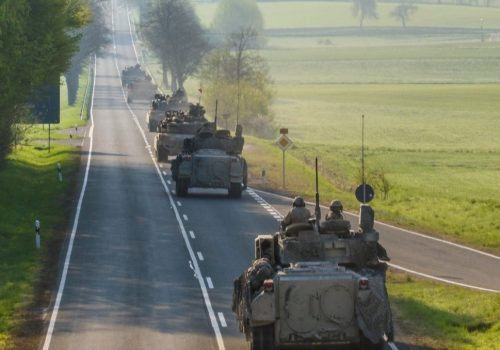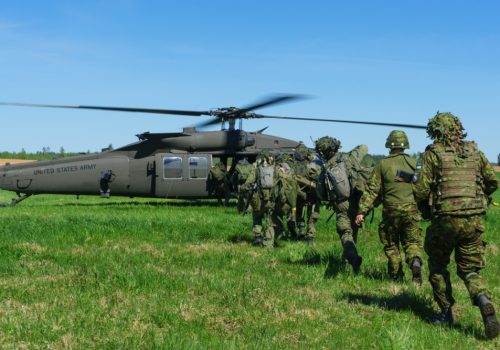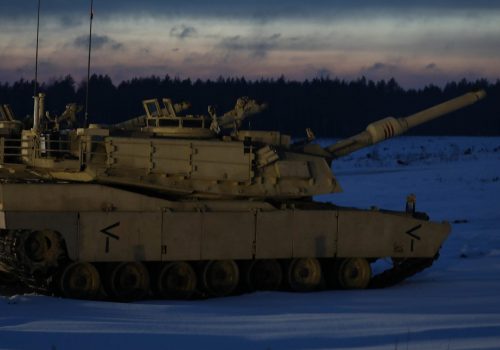Predictable strategy and unpredictable operations: The implications of agility in Northern Europe

Foreword
Former Secretary of State Henry Kissinger describes the current security environment as the most complex and volatile since World War II. The challenges we face demand creative and disruptive solutions. In that context, Dynamic Force Employment was developed and implemented to enhance the military dimension of competition, deterrence, and responsiveness in the event deterrence fails.
The United States and its allies face strategic competition with revisionist China and Russia, along with the destabilization and proliferation challenges associated with North Korea and Iran. Meanwhile, violent extremist organizations remain a threat to the American people, our allies, and our way of life. While being careful to appropriately prioritize its responses, as a nation with global interests, the United States and its allies must effectively meet each of these challenges. To that end, the United States requires military capabilities and force posture that can support a coherent and comprehensive National Defense Strategy.
In addition to the dynamic geopolitical landscape, today the United States finds itself at a point where its competitive advantage has eroded, operational requirements have increased, and the pace of technological change has fundamentally affected the character of war. These trends require continued adaptation on the part of the United States, as well as its allies and partners. During my time as the Chairman of the Joint Chiefs of Staff, we began to focus on change in four primary areas: how we plan; how we support strategic decision making; how we manage the force; and how we develop and design the force of tomorrow. Work in all of these areas must continue to ensure success in the transregional and all domain challenges of the twenty-first century.
Dynamic Force Employment (DFE) is simply a part of this effort to adapt in response to the much broader political and military strategic challenges the United States faces. But, properly designed and implemented, DFE can be impactful by providing proactive and scalable military options while maintaining and helping rebuild readiness. This paper offers an astute analysis of the concept, how it is evolving in practice, how it can further achieve its intended strategic effects—and perhaps most importantly—how the United States can continue to integrate its greatest competitive advantage: its allies and partners, particularly members of the NATO Alliance.
I can think of no better organization to assess how the United States can integrate its allies and partners further into our defense strategy and operations than the Atlantic Council. This paper provides an excellent construct for doing just that, and is useful reading for understanding how the United States and its allies can embrace adaptation in the use of the Joint Force.
General Joseph F. Dunford Jr., USMC (Ret.)
Former Chairman of the Joint Chiefs of Staff

The strategic context for dynamic force employment
Today the United States and its allies face an increasingly aggressive and emboldened challenge from revisionist powers to the post-World War II, liberal rules-based order. The international environment is increasingly multipolar and competitive, with the United States and its allies on opposing sides of a strategic competition with China on one hand and Russia on the other. This multimodal arrangement is also shaped by numerous other challenges and trends that have caused an accelerating erosion of the long-held US military competitive advantage.
As ever, all of this occurs in a security environment where finite resources yield meaningful constraints for security-policy decision makers and force hard decisions to balance priorities. In this environment, the US military is becoming increasingly agile in terms of the strategy it employs, the way it operates, and the capabilities it develops and employs.
As an initial step towards a more agile military force, the US Department of Defense introduced the Dynamic Force Employment (DFE) concept. DFE is a new operating concept for the US armed forces that seeks to more flexibly use ready forces to proactively shape the strategic environment while maintaining readiness to respond to contingencies and ensure long-term war-fighting readiness. In concept, DFE is intended to introduce unpredictability in force employment, provide proactive and scalable military options for strategic effect, and maintain and rebuild readiness. Former Secretary of Defense James Mattis characterized DFE as “strategically predictable, but operationally unpredictable.”
This report sets out to examine DFE on multiple facets, first identifying its origins and how it has transitioned from a concept into an operationalized process. It also seeks to assess the degree to which the application of DFE is achieving its stated design goals and how this employment construct is impacting allied plans and posture, while intending to inform the conversation on how the employment of US (and allied) forces can be used to achieve the NATO Alliance’s strategic aims. Lastly, it aims to anticipate what the fate of DFE might be given the Biden administration’s priorities and the ongoing strategic reviews.

Key assumptions in the National Defense Strategy
DFE is employed under a defense strategy premised upon three key assumptions. These assumptions are integral to the idea that by using operationally unpredictable actions and DFE as a tool, the US Department of Defense can achieve strategic impacts in support of the military dimension of a national strategy for competition.

A global operating model
The challenges of strategic competition and the realization that the US joint force was ill-prepared for warfare against a near-peer adversary drove the development of a more globally integrated and top-down approach to posturing the joint force—the Global Operating Model (GOM), which DFE and a more agile force is intended to operationalize.
An explanation of the GOM and DFE might be summarized in this way: In order for the United States military to compete effectively it must have sufficient forces to serve in all aspects of a potential conflict, including at the front line, standoff capabilities to blunt an adversary’s strategic aims, an ability to surge further forces for a particular conflict, and sufficient forces to continuously defend the homeland. However, the demand for readiness and resource constraints do not allow the United States to have forces deployed at all times in all desired locations, especially given rogue threats beyond Russia and China.
The DFE concept is intended to mitigate this risk by demonstrating the US joint force’s readiness and agility to respond rapidly to emerging threats globally. The DFE framework further mitigates risk by introducing uncertainty in the operational environment through proactive deployments intended to complicate adversaries’ planning and demonstrates lethality and resolve.

Implications for allied defense planners
Whether the Dynamic Force Employment construct is maintained or adapted under the Biden administration, an agile operating concept that provides DoD a tool below the level of armed conflict for use in global competition is one that is unlikely to fall to the wayside. As such, there are a number of potential trends worth greater assessment. This report expands upon the following implications of a more agile force:
- Integration and communication will determine whether DFE is “strategically predictable.”
- Europe will see more episodic shifts in US forward presence.
- Middle East priorities will still draw resources.
- Greater stress will be placed on high-readiness forces.
- DFE offers lessons-learned to refine operational plans and capabilities.
- There will be greater opportunity and necessity for intraregional operations.
- Whether the DFE process mostly occurs in the sea, air, or land domains will be based on ease.
- Battle handover and multidomain operations are of increasing importance.
- Capabilities that counter Russia’s A2/AD bubbles are a unique factor.

Recommendations
Based on these implications, the report offers the following menu of suggestions for the United States and its NATO allies and partners that is designed to: offset any risks that occur naturally as a new defense strategy and operating concept are implemented; appropriately plan for and adapt to evolving models of transatlantic defense cooperation and defense planning in Northern Europe; and harness the benefits of the DFE concept and a more agile US force in a way that enhances NATO’s dual-track strategy of deterrence and dialogue vis-a-vis Russia.
Steps for the United States
Integrate allies and select partners more thoroughly into the DFE process.
At present and in part due to classification issues, allies are frequently in the dark as to the strategy and intent behind the concept as well as the criteria for the DFE process and specific planning around DFE deployments. This hinders the concept’s effectiveness in competitive spaces where allies are critical. The United States needs to explain to allies how the DFE concept fits into its broader competitive strategy. Going forward, the United States should ensure that allies are fully aware of the strategic intention of the DFE concept, are involved appropriately early in discussions on where and how DFE deployments are expected to effect strategic outcomes or offset gaps in US forward presence, and are involved in the planning of specific DFE deployments. This will allow allies to go beyond simply tactically accompanying DFE deployments and instead complement US efforts at the strategic and operational levels through revisions in their own posture, activity, and information operations. Greater joint planning will have the added benefit of incorporating allies’ and possibly partners’ regional expertise into the decision-making process—which could be uniquely helpful in places like the Atlantic Ocean, High North, Baltic Sea, and Black Sea regions. In the short term, the solution will need to be a timeline that balances US concerns over operational security with allies’ desire to be involved from the onset. Such a balance should be ironed out based on practice and given the budgetary-driven yearly planning cycle for DFE deployments, and the timeline could potentially be four to five months.
Consider new memoranda on operational security and information sharing.
Achieving unpredictability in any planning horizon hinges on secrecy and the United States naturally needs to protect parts of its sensitive OPLANs and planning for routine deployment in order to be successful. While this does create a problem to varying degrees for integration and joint long-term planning with allies, it can be mitigated. Today, the information sharing afforded to NATO allies by NATO Secret levels of classification is seen as fairly sufficient. However, as technology evolves and bureaucratic obstacles arise, DFE deployment timeline considerations and classification levels may change faster than modifications to NATO-wide or bilateral information-sharing arrangements allow. In order to improve DFE’s strategic effectiveness in areas where allies are critical, maintaining operational security along with close communication is an absolute must and can be further enhanced through additional memoranda of agreement (MOA) and technical discussions on information sharing. These MOA can be bilateral, modeled after the one recently signed between India and the United States in October 2020 or the long-existing agreement with France. Or, in an effort to allow for greater cooperation in a more dynamic environment, these MOA can be multilateral and broader, modeled after current Five Eyes information-sharing agreements. In either form, these agreements can be used to allow more specific uses of information sharing that may not be available within the NATO framework and can lead to stronger cooperation and coordination for DFE deployments. The end result would be a more agile coalition capable of meeting emergent threats on shorter timelines.
Connect information operations to Dynamic Force Employments.
To ensure it supports broader national security objectives for competition and matches the DFE concept’s intent, each DFE deployment should be complemented by strategic messaging by the United States and, wherever possible, coordinated with messaging from allies and partners. NATO’s underlying strength and ability to shape Russian behavior is not its military capability but its political cohesion—a fact that should be more prominently leveraged in the information environment to signal and metaphorically surround Russia as part of a competitive strategy. This would likely have the greatest impact in ensuring the DFE concept can alter Russia’s decision calculus. Lessons can be learned from NATO’s integration of strategic messaging into its major exercises over the past three years. Practically, a criterion should be added to the principles of the DFE process that states there must be an opportunity for strategic messaging before a DFE deployment is approved. Coordination within the interagency as well as public affairs and other information elements must be incorporated in the planning process, much like in the freedom of navigation operation (FONOP) program. The US Department of State should be more heavily involved in or aware of the planning of DFE deployments and play a large role in strategically messaging their occurrence at an appropriate stage.
Assess where operationalizing Dynamic Force Employment can be coercive or destabilizing.
Impacting an adversary’s decision-making is a high bar to clear. And not understanding if and when an adversary is reacting to agile force movements, and why, is a dangerous proposition. DoD should develop a comprehensive set of indicators to evaluate the impact DFE deployments have on an adversary and evaluate this data over time. This should include data gathered by allies and partners to help determine how deployments can have added benefit in the competitive environment as a coercive tool beyond filling gaps in allocated posture and without inadvertently leading to escalation.
Steps for the Alliance as a whole
Invest in resilience and secure logistics and transportation infrastructure.
If the United States, and likely therefore the Alliance, is to depend on rapid reinforcement for deterrence and defense, it must dedicate much more significant resources to resilience. This should include expanding and dispersing equipment and munitions stockpiles to facilitate the dynamic deployment of ground forces; improving and duplicating lines of communication; hardening, defending, and dispersing points of debarkation; and strengthening the cybersecurity of logistics and transportation networks.
Emphasize battle handover in exercises.
NATO exercises should more frequently test the Alliance’s battle handover capabilities. Large-scale exercises such as Defender Europe 2020 and 2021 are already testing rapid reinforcement concepts, but NATO and bilateral US exercises from large to small should include handover from national to NATO or US command and control as well. Preparation for battle handover should also be given higher priority in NATO’s ongoing development of the Concept for Deterrence and Defense of the Euro-Atlantic Area.
Seek opportunities to integrate activities on NATO’s flanks.
The DFE concept is likely to highlight the interrelation between NATO’s flanks. The United States should continue to emphasize agility in this regard, using DFE deployments between regions as a forcing function for narrowly focused allies to more closely consider intraregional dynamics. Allies in Northern Europe should take particular advantage of this trend to exercise and plan for operations between the High North and the Baltic Sea. Such developments would be beneficial for aligning threat perceptions and reinforcing cohesion within NATO.
Leverage NATO’s strategic political effect in support of allied operations.
Establishing a consensus view on a singular issue is a distinct Alliance advantage. Even when military action is not taken by the Alliance and instead by individual allies, providing consensus political support from thirty allies for that action is immensely effective. This political effect was evident in the allied response to Russian public statements on the US withdrawal from the INF Treaty. Additionally, when all NATO allies attribute fault for hybrid acts below the threshold of conflict, it provides a solid basis of political support for specific allies to take action outside of NATO structures, navigating around the delays that come when allies might differ on what exact operational response to take. Further leveraging this political-then-operational approach can ensure that when DFE deployments are intended to challenge hybrid threats from Russia, they will be more likely to achieve strategic objectives if connected to a clear signal of allied solidarity.
Steps for European allies
Invest in complementary capabilities.
As allies make future investments, priority should be placed on those capabilities that allow them to integrate and take full advantage of US forces as they rapidly arrive. These could include among a host of others: command and control; cyber; electronic warfare; intelligence, surveillance, and reconnaissance capabilities to support targeting requirements for long-range fires; national long-range fire systems, which are most valuable in the early stages of a conflict; battle management systems to take advantage of the F-35’s data-collection capability; and littoral strike capabilities and concepts that take advantage of the geography in the High North and Baltic Sea, as well as the agility of the US Marine Corps, the UK’s Corps of Royal Marines, and the Netherlands Marine Corps. Perhaps most importantly, this should mean a concerted effort by allies to build joint capabilities from the ground up and coordinate efforts with the United States at every stage of the combat development process.
Build more European coalitions of the willing.
Facing resource constraints, European allies will be hard pressed to combine force structures designed to protect national sovereignty alone with elements that allow them to complement US dynamism. Greater multilateral action is likely to be the answer, but not through NATO, which faces concerns over its speed of decision-making. Instead, smaller groupings including the Nordic Defence Cooperation (NORDEFCO), the UK-led Joint Expeditionary Force (JEF), and other regional initiatives are likely to be the pathway for smaller nations to develop flexibility and participate at least partially in a joint force structure that multiplies capability and enables greater activity. European allies should reinforce these existing arrangements (in particular the Northern European-focused JEF and NORDEFCO) and seek other opportunities for operational cooperation in other initiatives. While the limitations of the Alliance might not allow for NATO-assigned units to conduct DFE deployments now, NATO’s DDA concept is paying dividends outside NATO structures. On an individual and focused multilateral basis, allies, recognizing the requirement for recapitalizing a combat-effective force, are already developing deterrent postures and incorporating operations that display the agility critical to making DEF a successful operating concept.81 This is a positive step in the direction of smaller group activity, and efforts along these lines should be encouraged.
Strengthen bilateral dialogue with Russia.
At a time when the definition of strategic stability in Europe is changing due to the introduction of various nuclear and conventional capabilities, and when routine dialogue channels with Moscow are weakened, existing channels need to be utilized as much as possible. Norway’s bilateral dialogue with Russia on stability in the Barents Sea region and the High North more broadly should be emphasized as a key channel for communicating allied intent and defense activities while also assessing Russian responses. Until such time as broader channels like the NATO-Russia Council can be brought back to life, allies’ bilateral dialogue with Russia should be discussed at NATO so as to ensure allies are communicating as coherently with Russia as possible and avoiding activities that hinder the competitive strategy.

Read the full report
Related content
Subscribe for events and publications on transatlantic security
Sign up for updates from the Atlantic Council’s Transatlantic Security Initiative, covering the debate on the greatest security challenges facing the North Atlantic Alliance and its key partners.
Related program

The Transatlantic Security Initiative, in the Scowcroft Center for Strategy and Security, shapes and influences the debate on the greatest security challenges facing the North Atlantic Alliance and its key partners.
Acknowledgements1Foreword: Icon made by Freepik from www.flaticon.com; The strategic context for dynamic force employment: Icon made by Perfect pixel from www.flaticon.com; Key assumptions of the National Defense Strategy: Icon made by Freepik from www.flaticon.com; A global operating model: Icon made by Freepik from www.flaticon.com; Implications for allied defense planners: Icon made by prettycons from www.flaticon.com; Recommendations: Icon made by Kiranshastry from www.flaticon.com; Read the full report: Icon made by Good Ware from www.flaticon.com;





